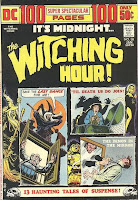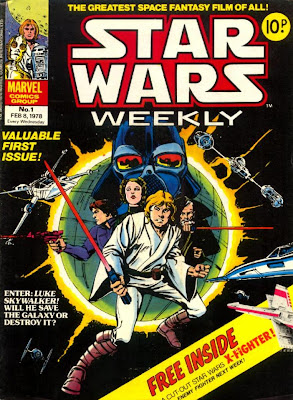"It's simple," I tell them. "I got the first quality from drinking a strange frothing formula that turned me into a perfect physical specimen of humanity. I then had to kill the scientist responsible so there could never be any others like me. The second quality I got from reading too many issues of Captain America."
You guessed it. Thanks to my recent spending spree, I've been reading Essential Captain America Vol 1
Now, I must own up that I bought it because it was going cheap, rather than through any huge compulsion to catch up with the star-spangled superstar. In truth I read most of these tales as a kid, in the pages Marvel UK's The Titans but to say my memories were vague would be an understatement.
Still that didn't stop me leaping in with my usual gusto.
Surprisingly, Cap's Silver Age series doesn't kick off with his origin. Instead we leap straight into the action, with him seeing off a gang of crooks who break into the Avengers' Mansion. This lays down an early template with Cap repeatedly coming up against gangs of brawlers who he soon sees off with his fighting skills in what're clearly just an excuse for Jack Kirby to draw punch-ups.
After just a few stories however we're suddenly flung back into the past as, instead of present day tales, we're given a diet of World War Two outings. As with the very early Hulk comics, you get a feeling of Lee and Kirby not being quite sure what to do with the strip and trying different approaches to see what sticks. It's during this period that we get the classic retelling of Captain America's origin.
We also get the origin of the Red Skull, which comes after a jarring leap from the events of the previous issue, with no explanation of what happened in between. That aside, this is easily the best of the WW2 tales, even if the Skull's ascent from mere bellboy to arch-villain relies a little too much on luck on his behalf.
Clearly Lee and Kirby decide the WW2 approach isn't what the readership want because, after a few issues, they switch back to tales set in the present. Once there, the stories settle into one of two moulds. Either Captain America comes up against the always irritating Batroc the Leaper who quickly realises he's better off helping Cap than fighting him, or a mystery villain kidnaps SHIELD's enigmatic Agent 13, and Cap has to launch a one-man attack on his base to rescue her. The mystery villain nearly always turns out to be either the Red Skull or the almost identical Baron Zemo, and so the regular shock revelations rarely come as a shock.
For some reason, Lee and Kirby seem reluctant to move away from a James Bond template and also seem to fear straying too far from Cap's past, as we keep getting World War Two menaces repeatedly rising from the grave to pester him. This trend reaches its nadir when, in the present, he finds himself up against the 1st, 2nd and 3rd Sleepers, giant robots created by Hitler to destroy the world in the event of his defeat. To say the Sleepers are among the lamest robots ever seen in comics would be an understatement. Basically think of a giant robot hanging from a flying manta ray with a giant metal skull on top.
The one major exception to this World War Two-ness is the introduction of the huge-headed Modok who, despite being arguably the most interesting villain of the collection, only appears in one tale and isn't seen again, as we get yet more of the Red Skull and Zemo.
Modok aside, perhaps the strip's two most impressive creative contributions during this volume are the introductions of the Cosmic Cube - that little box that allows its owner to do anything he wants - and the 4th Sleeper, a Nazi robot far superior to its predecessors which, thanks to its control over its density, can walk around underground while firing devastating force beams upwards to destroy whole swathes of real estate.
One of the things you can't miss when reading this collection is that Captain America isn't a Silver Age character. He's a Golden Age one, crafted long before the Marvel template for the fallible hero was laid down, making him much less interesting than other Marvel do-gooders. There's also the problem that he'd been in suspended animation for nearly twenty years before returning in The Avengers and so, unlike other Marvel heroes, has no inbuilt supporting cast.
Lee and Kirby try to remedy this by making SHIELD and its agents his supporting cast but there's an obvious problem that, while this makes some sense - bearing in mind Nick Fury's shared World War Two background with Cap - it means it's Captain America's supporting cast and not Steve Rogers'. In these tales, Rogers literally has no existence. He has no family, no friends, no neighbours, no job, no interests, no hobbies. We simply never see him other than when he's about to become Captain America.
Even when Lee and Kirby try to give our hero a love interest in the shape of Agent 13, she's not Steve Rogers' love interest, she's Captain America's. Despite being in love with him, for most of this volume Agent 13 never even sees him without his mask. And when he finally does reveal his true identity to her, we get the unlikely sight of them on a date, with him referring to her throughout as, "Agent 13". Gwen and Peter this isn't.
There's also the somewhat bizarre idea that Cap's in love with her because she's identical to a resistance fighter he loved during the War. At one point it's hinted that Agent 13's the younger sister of that original love interest, making Cap's infatuation the sort of thing a psychiatrist would have a field day with. Fortunately, after their first meeting, that particular idea's never mentioned again. Nor is the fate of that original love interest, last seen in the 1940s, wandering off with amnesia.
This failure to develop Steve Rogers is a glaring weakness in the strip and means that while other Marvel titles of the era were able to widen and deepen their dramatic appeal though the heroes' private lives, the world of Captain America, even his love life, effectively becomes one long fight scene.
If the tales tend to be uninvolving on an emotional level, the upside of them is Jack Kirby's art which, mostly inked by Jolting Joe Sinnott, looks as good as it ever did, up until the final few stories when Syd Shores takes over the inking. I don't like to be mean but I've never liked Shores' inking and for me it does Kirby's work no favours here.
All in all, I can't get round the fact that there're good reasons I didn't previously remember these tales. Their reliance on action action action can make it a hard grind ploughing through them at times and you really do start to feel you're reading the same story over and over again. Still, it's yet another piece of Marvel's history caught up on and I did at least become reacquainted with the births of the Cosmic Cube, AIM and Modok.
The things I learned from reading Essential Captain America Volume 1:
1. Captain America survives most of his fights by dumb luck. In virtually every story, there's a point where the bad guys could kill him but choose not to because, "That would be too easy," or because, despite being ruthless killers/assassins, they're only packing stun guns.
2. All foreigners are stereotypes.
3. The Red Skull thinks Scotland is in England.
4. All vehicles belonging to top secret organisations whose existence the world knows nothing of, have the name of that organisation written on them in giant letters.
5. The Avengers have daily meetings with military types, at which they're given the current co-ordinates and travel plans for every US naval ship and submarine. Those meetings must just fly by.























































































































